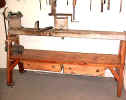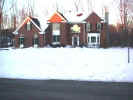





 I
started my woodturning at Pretoria Boys High school in
I
started my woodturning at Pretoria Boys High school in South Africa in 1966, where, as part of my eight grade school
woodwork project I was required to turn a lamp stand. This item still stands in my workshop as a memory to those early
beginnings and the start of my love for the art of woodturning. I was fortunate to have an engineering father, Harold,
who built a home lathe and this allowed me to maintain an active interest until I moved to Cape Town.
South Africa in 1966, where, as part of my eight grade school
woodwork project I was required to turn a lamp stand. This item still stands in my workshop as a memory to those early
beginnings and the start of my love for the art of woodturning. I was fortunate to have an engineering father, Harold,
who built a home lathe and this allowed me to maintain an active interest until I moved to Cape Town.
 There
I was able to build my own larger lathe for the princely sum of $45 and this I used for 20 years. I pensioned it off in
1999 when I moved to the
There
I was able to build my own larger lathe for the princely sum of $45 and this I used for 20 years. I pensioned it off in
1999 when I moved to the USA and succumbed to the temptation of a Oneway 2436, which is one of the best lathes on the market.
USA and succumbed to the temptation of a Oneway 2436, which is one of the best lathes on the market.
I spent ten years in Hong Kong where I became known as the typhoon turner, because all the wood I used
was collected as the result of the many typhoons which blow through that area. While the rest of the population had
taken cover from the storm, I could be found, chain saw in hand, helping the council clear the roads of fallen trees. It
was in Hong Kong that I really stated to turn big stuff and to get into turning the root balls of trees with all their
interesting inclusions. The move to Hong Kong as the director of an American pharmaceutical company was initially a
frustrating one, for the lathe had to stay in storage because apartments in Hong Kong are not very spacious. It was only
after four years that a suitable house in the New Territories allowed for a workshop to be set up and for the lathe to
be shipped over. That was when one of the only benefits of the typhoons became very apparent. Each year the harvest was
put up to dry either, as cut logs, or as green turned forms to be finished at a later stage.
Our move to the USA in 1998 was a major boost to my turning as I was able to join the New Jersey
Woodturners Association. I also traveled to the UK where I did his first formal weekend course with Dave Regester and
was able to see some of the top UK turners in action at the Axminster show.
Most of the work that I do focuses on what nature has already started and it is the wood, together
with its flaws and faults, that really determines what the finished item will look like. Many of the pieces will be
finished with natural edges or bark inclusions. The more the ants, borers and other elements of nature have done their
work, the more I am attracted to the piece. It was only in the USA that spaulted timber came onto the radar screen and
has been a favorite whenever it can be found. I have also done some more formal pieces and am always experimenting with
new ideas.
 My
family now reside in Mendham, New Jersey and the kids are starting to eye the old lathe, so hopefully one of them will
become a chip off
My
family now reside in Mendham, New Jersey and the kids are starting to eye the old lathe, so hopefully one of them will
become a chip off the old block and turn a few pieces worthy of the Fuge name.
the old block and turn a few pieces worthy of the Fuge name.
Fuge's Wild Woods
